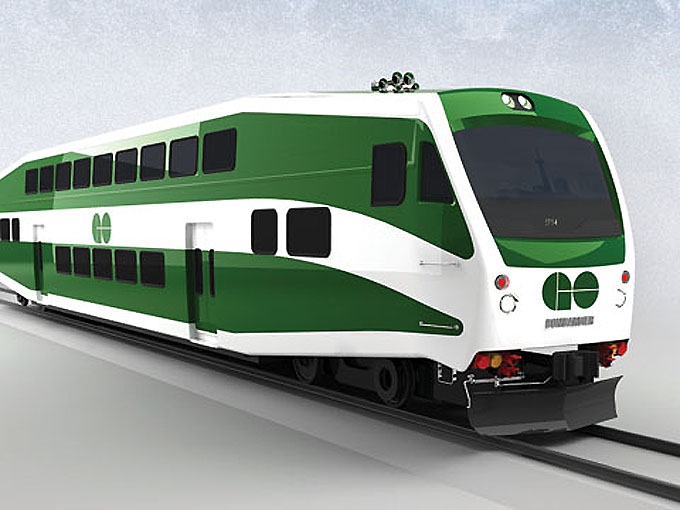
The Ontario government has inked a deal worth approximately $1.6 billion to implement the first phase of a mammoth project that could see GO Transit’s entire rail network electrified, potentially opening the door for much more frequent and faster train service.
A senior government source with knowledge of the contract but not authorized to speak publicly told CityNews ONxpress Transportation Partners, the consortium chosen to carry out the “development” phase, will be responsible for designing key infrastructure, signalling, system and Hydro One power infrastructure upgrades as well as starting construction to separate certain rail-road crossings over the next two years.
However, all of the money and approvals needed to fully build out the completely electrified rail system haven’t been finalized yet. Also, while construction is set to begin in 2023 and shorter-term projects could result in incremental increases to GO Transit service in 2025 or 2026, the current potential finish date for electrification is currently pegged for around 2032.
The source noted the full scope of work for electrifying each line and the final budget will depend on the work done by the consortium. Billed by Infrastructure Ontario as the largest project in the expansion of GO Transit rail, the full contract also calls for operating and maintaining the whole rail network for 25 years.
In addition to an all-new electric train fleet (the current trains run on fuel), more than 200 kilometres of new tracks would need to be installed and more than 600 kilometres of tracks would need to have electric wires and related infrastructure installed (similar to a light rail transit or streetcar system). An all-new set of electric trains would also need to be purchased and additional infrastructure would be needed to support it.
Electrification would allow trains to potentially reach up to 140 kilometres an hour under certain conditions, faster than the current fleet.
If ultimately carried out in full by the provincial government, the source said the busiest routes such as the Lakeshore West line could see trains arriving as soon as every three-and-a-half minutes during the most in-demand times.
“It’s going to be a huge undertaking to add new tracks, electrify our current tracks and increase speed across all lines,” the source said.
“That would help to make them more efficient than driving.”
The work on electrifying key segments of GO Transit’s rail network as well as purchasing some rail corridor space and beginning the initial bidding work started under the previous Liberal government, but the contract signed under the current government marks a more definitive step forward in creating all-day, two-way GO train service across the network. Negotiations with the consortium have been underway for months.
By 2055, officials estimated there will a huge growth in ridership with an estimated 200 million passenger trips annually.
While a formal statement on the first phase of the electrification program was issued Tuesday morning without a public event, it marks the latest in a recent string of transit-focused announcements for the Ford government ahead of the June 2 election.
Among the recent announcements was the start of tunnelling for the Eglinton Crosstown West LRT extension, the ground-breaking for the Ontario Line subway — a project initiated by the provincial government — at the end of March as well as news $75 million was going to be spent to bring back Ontario Northland train service between Toronto and Timmins after it was cancelled in 2012.
GO Transit Electrification And Increase In Service ‘Game-Changer,’ Experts Say
Jonathan English, the director of transportation policy for the Toronto Board of Trade, was among those on Tuesday welcoming news of the initial investment.
“It’s the complete game-changer for the GTA. These lines are going to function a lot more like subways than commuter trains,” he told CityNews.
“It’s a lot more than electrification. This is about massive service expansion, much more frequent trains and the kind of service that functions more like a subway than a commuter train GO has been in the past.”
English said with changing travel patterns, in part due to the COVID-19 pandemic, there will likely be fewer people using the service for just commuting to and from downtown Toronto for work.
“It’s much more of a local service,” he said, reiterating the Toronto Board of Trade’s calls for fare integration across the GTA and boosting the frequency on community transit routes.
Matti Siemiatycki, the director of the University of Toronto’s Infrastructure Institute and a geography professor, said after decades of underinvestment in transit, Tuesday’s news “another important step” for the GTA.
RELATED: Eglinton Crosstown completion, Ontario Line groundbreaking among 2022 Toronto transit plans
“This announcement is really an investment for generations. It’s a decision today that will enable GO to run more frequent service, to expand capacity and to ensure the service is of a high quality to attract people back as the projects come online,” he said.
“It’s the two-way service that’s being added and expanded that really is the game-changer. That allows this to be a much more integrated region. It doesn’t just see the 905 as the bedroom to the downtown core but rather enables employment growth throughout the region.”
However, despite praising the Ford government for “moving very quickly” on a variety of transit projects during its first term, Siemiatycki said with the upcoming election there needs to be a focus on this and other major transit initiatives to ensure completion.
“And the idea that if it’s fully funded… The fact that we’re still talking about ‘if’ should perhaps raise eyebrows and concerns in this region because we’ve seen projects that have started, and then stalled and then stopped or funding has changed as governments have changed,” he said.
Meanwhile, the pair both stressed the need for continual and additional investments going forward.
“GO Transit is the rail backbone for our entire transit system. We are a region now of millions of people that spans a huge geography and what allows people to get around, what allows them to get to work in large measure is the GO system as well as our local transit services as well,” Siemiatycki said.
“This is something where we’re going to need to see the commitment to the investment needed when we do see the final design and how much this is going to cost. The timeframe is understandable considering the scale and the scope of the project,” English added.






